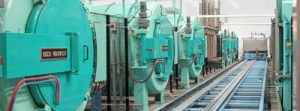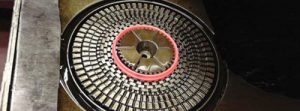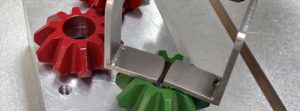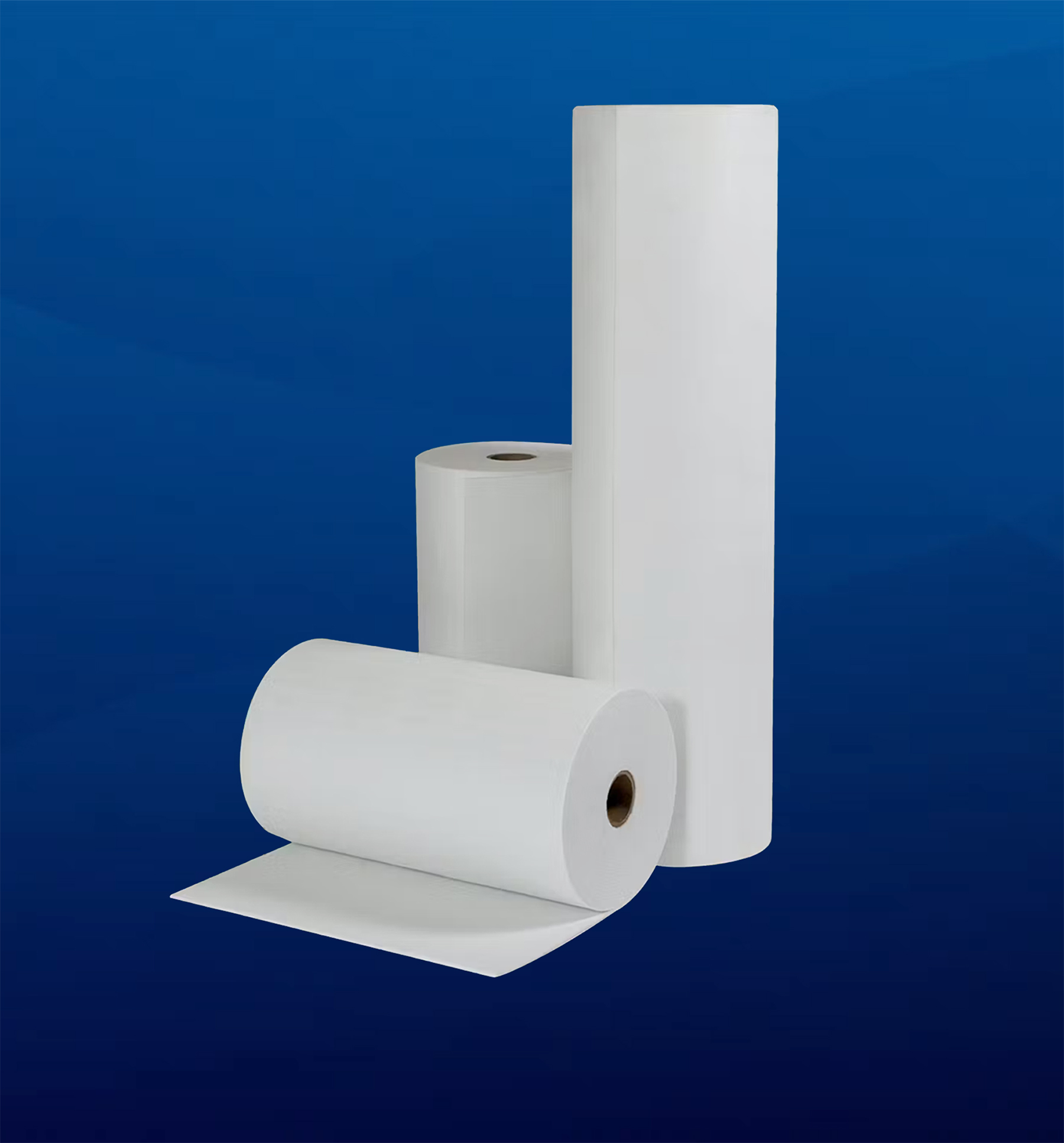
High-pressure gas quenching (HPGQ) involves quenching an austenitized part in an inert gas, resulting in a cleaner part and potentially reduced distortion compared to liquid quenching. Factors such as quenching gas pressure and gas flow around a part affect the cooling rate and the final distortion of the part. In this study, a Solar HPGQ furnace was characterized to understand quenching capability and variation throughout the working zone. Using steel test bars instrumented with thermocouples in a batch, thermal boundary conditions were fit for a wide range of pressures in an HPGQ furnace. With an understanding of the quenching equipment, distortion caused from quenching can be more accurately predicted through FEA modeling.
Case Study
The aim of this work is to determine a set of heat transfer coefficients (HTCs) for a wide range of HPGQ pressures. Thermocouples were embedded 6” axially from the end of cylinders, made from 1018 steel, with dimensions of 3” diameter and 24” in length. A production load of about 20 bars, eight instrumented with thermocouples and 12 without, was quenched with an HPGQ process using pressures of 2, 4, 6, 10, 15, and 20 bar nitrogen gas.

Figure 1 shows the time temperature data collected from one such run, and an image inset showing the racking configuration and furnace used in the experiments [1]. In addition to the temperature histories collected from the embedded thermocouples for each set of pressures, the data shows the variability in the furnace based on position in the quench chamber. Figure 1 shows that the cylinder in position two quenches much faster than the other cylinders in the load because it is situated directly in front of the nozzles that deliver the quench-gas to the chamber. In an actual production run, heat treaters consider part placement to avoid parts being placed in positions that have excessive cooling, which could result in increased distortion in the part after quenching. Understanding the variability of the process equipment is paramount to producing quality parts.
The collected time/temperature data was analyzed and averaged, forming a baseline time/temperature curve for each gas pressure that can be used to fit FEA model results. The FEA model was developed with attention to nodes placed at the thermocouple positions, as shown by the red dot in the far left image in Figure 2.

The axisymmetric model produced includes fine elements near the surface to capture the thermal gradient in the part during quenching. Several FEA models were executed with varying heat transfer coefficients applied to the exposed surfaces of the cylinder and the time/temperature data was compared to the averaged experimental data per furnace run. Sensitivity-based optimization using this forward finite element method is preferred for fitting the heat transfer coefficients as it provides very reasonable results compared to inverse or numerical methods. The predicted and experimental time/temperature results are compared, sensitivity analysis is performed using their difference to search for the optimum HTC value, and the process is repeated until the results are satisfactory. The HTCs developed can then be used to predict the material response during heat treatment, such as phase fractions, hardness, and distortion using the DANTE software, also shown in Figure 2.
The predicted time/temperature curves for each gas pressure level are compared to the averaged experimental data and the fit is very good for each gas pressure, shown in Figure 3. The time temperature curves show an interesting phenomenon during quench with a slope change around 700°C.

The mechanism causing the slope change is the release of latent heat during the phase transformation from the austenite phase to a ferrite or pearlite phase, which can be accurately captured by modeling the phase transformations during the simulation. It is worth noting that the latent heat effect is more significant in the slower cooling rates compared to the faster rates, and the effect is more significant with bulkier components as the phase transformation occurs simultaneously over a larger volume in bulkier sections than thinner ones. As AISI 1018 has a low hardenability, ferrite and pearlite are the dominant phases after quenching, while a higher alloy steel grade may transform to bainite or martensite depending on the cooling rate. It is important to include the effects of latent heat when fitting the time temperature data, as this can have a significant effect on the magnitude of the HTCs developed.
The thermocouple data shows a wide range of cooling rates based on the position in the quench chamber. Nonetheless, high (fast) and low (slow) cooling rates for each gas pressure were fit using the same method. This provides a range of acceptable HTCs that may be experienced by parts at each pressure. The results of these experiments are shown in Figure 4, with the blue line showing the average HTC developed from the fitting work, and the green and red lines showing the high and low cooling rates, respectively.

The results range from about 200 for the 2-bar quench to about 600 for a 20-bar quench. Engineers can use the HTCs developed, and the ambient temperature surrounding the parts, to simulate and predict the material response from heat treatment. Sensitivity analysis can also be performed to ensure the part response to the variation in cooling is acceptable using the high and low HTC values. Unlike liquid quenching where the overall ambient temperature of the quenchant does not change significantly during quench, due to the volume of the quenchant compared to the workload, the ambient temperature can vary in HPGQ. Often there is an initial spike in the ambient temperature of the gas as the parts quickly heat the gas in the chamber before the heat exchanger can compensate, and this phenomenon must be accounted for to ensure accurate results.
The atmosphere-protected high-pressure gas quench process is an effective quenching method when part surface quality and distortion are a concern. As with all heat-treatment processes, there exists variability and nonlinear material response that influences the final dimensions, hardness, and residual stress within the parts produced. Modeling the parts response during heat treatment can help ensure specifications are met and quality parts are produced without excessive rework or scrap costs. Data collection has become more commonplace as acquisition methods become more affordable and widely used, but what to do with these data is often the question. This work provides an overview of the methodology for developing heat transfer coefficients, from collected time/temperature data, that engineers can use to accurately model the HPGQ process. Moreover, this method of HTC determination is not limited only to gas quenching. It can be applied to any quenching process or medium to produce the HTCs over a wide range of process equipment conditions and temperatures. With an understanding of the quenching equipment, ambient temperature, and heat-transfer coefficients, distortion caused from quenching can be more accurately predicted through heat treatment simulation.
REFERENCE
- Photo and data credit to Solar Atmospheres.

























